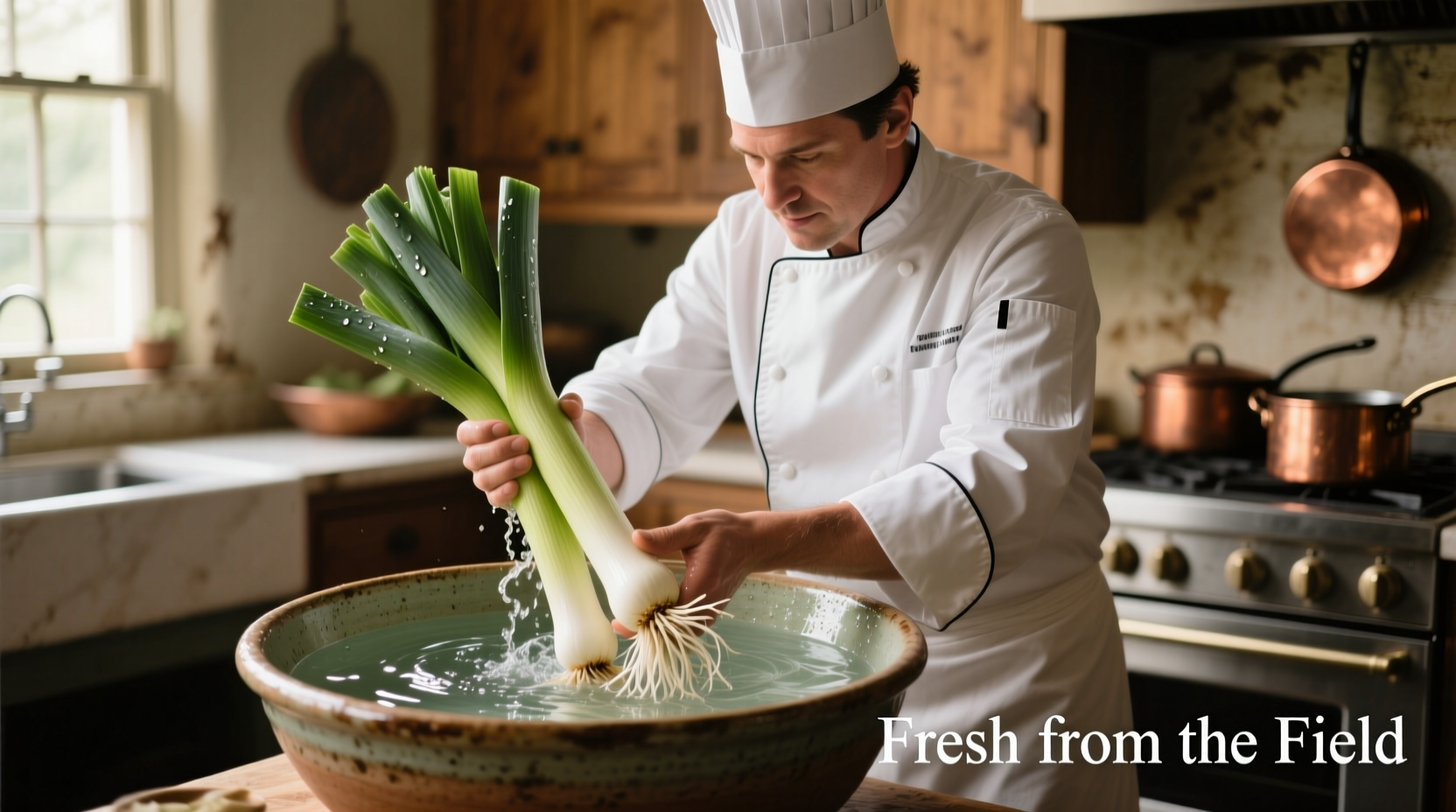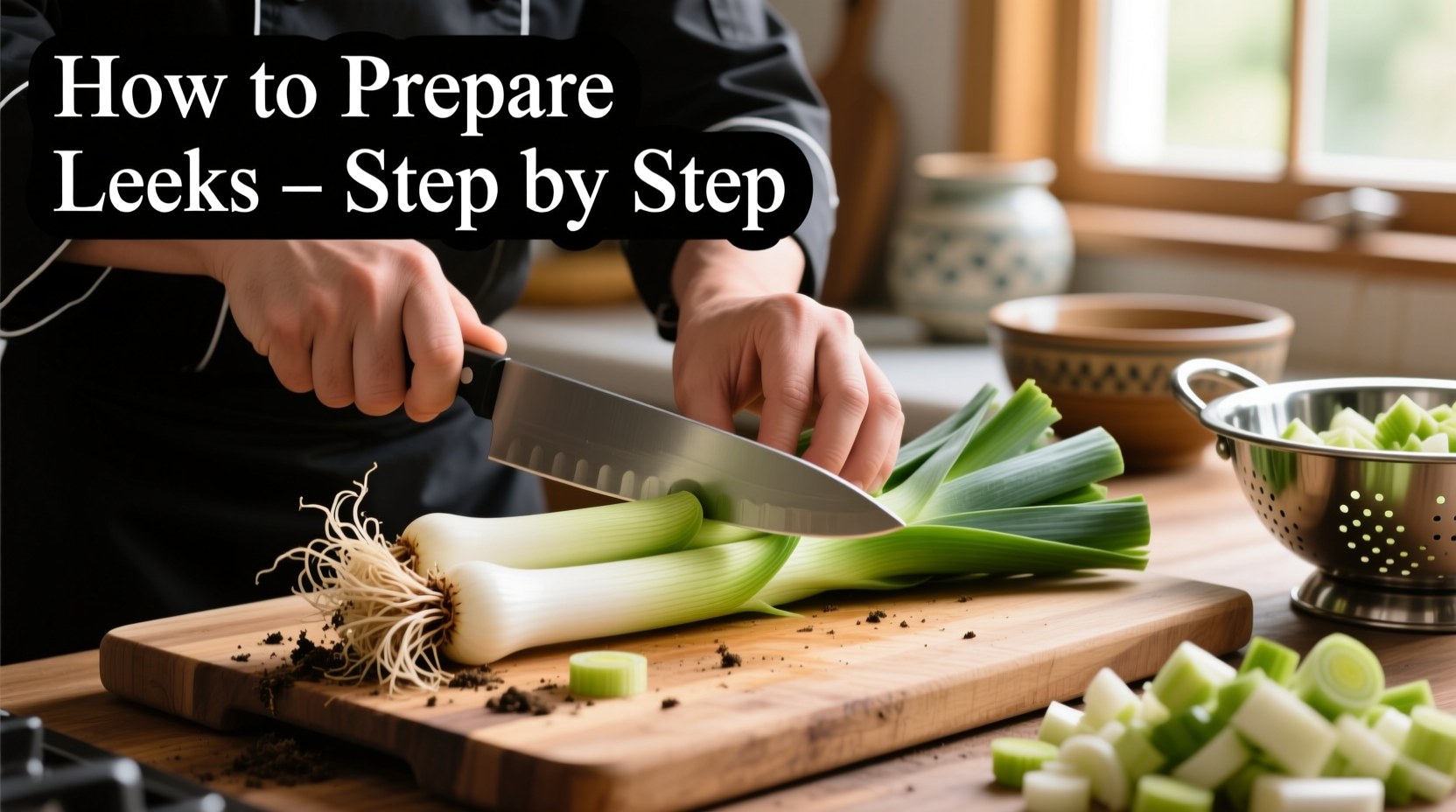Cut off the dark green tops and root end, slice lengthwise, and soak in cold water to remove hidden dirt. Properly cleaned leeks should be free of grit and ready for slicing into your favorite dishes. This complete guide shows professional techniques for selecting, cleaning, trimming, and cutting leeks to maximize flavor and minimize waste.
Leeks often fool home cooks with their deceptively clean appearance. What looks pristine frequently hides layers of stubborn soil between the concentric rings. A single gritty bite can ruin an otherwise perfect dish. This comprehensive guide reveals the professional chef's approach to leek preparation that ensures clean, flavorful results every time. You'll learn not just how to clean leeks properly, but how to maximize their culinary potential while minimizing waste.
Why Proper Leek Preparation Matters
According to the USDA Agricultural Research Service, leeks rank among the dirtiest vegetables due to their growth pattern, with soil accumulating between layers. Improperly cleaned leeks introduce unwanted grit into dishes, compromising texture and potentially damaging teeth. The University of California Cooperative Extension confirms that thorough cleaning preserves the delicate onion-like flavor while eliminating contaminants. Professional kitchens dedicate significant time to proper leek preparation because they understand that clean ingredients form the foundation of exceptional cooking.
Essential Tools for Leek Preparation
Before starting, gather these kitchen essentials:
- Sharp chef's knife (8-10 inches)
- Sturdy cutting board
- Large bowl or container
- Colander for final rinse
- Vegetable peeler (optional for tougher outer layers)

Step-by-Step Leek Cleaning Process
Selecting Quality Leeks
Choose leeks with crisp, firm stalks and vibrant green tops. Avoid those with yellowing leaves or soft spots. The ideal leek has a substantial white base that tapers gradually to green. Thicker leeks work better for grilling or roasting, while thinner varieties excel in soups and sauces. According to culinary research from the Culinary Institute of America, peak season for leeks runs from fall through early spring, when they develop their sweetest flavor profile.
Trimming Leeks Correctly
Remove the dark green leafy portion (about two-thirds up the stalk) and the root end. Reserve the dark green tops for making vegetable stock—they contain valuable flavor compounds but are too tough for most recipes. The white and light green sections contain the tender, edible portions. For recipes requiring whole leeks (like braising), cut just below the root to maintain structural integrity.
The Critical Cleaning Stage
This is where most home cooks fail. Slice trimmed leeks lengthwise through the white base, stopping before the green portion separates completely. Submerge in a large bowl of cold water and gently separate the layers. Swirl the water to dislodge trapped dirt, then let sit for 5-7 minutes—this allows soil to settle at the bottom. Lift leeks from the water (don't pour, which would reintroduce dirt), then rinse under cold running water while separating layers. Repeat if necessary until water runs clear.
| Cutting Technique | Best For | Preparation Time | Yield |
|---|---|---|---|
| Half-moon slices | Soups, stews, quiches | 3-4 minutes | 1 cup per medium leek |
| Julienne sticks | Stir-fries, garnishes | 5-6 minutes | ¾ cup per medium leek |
| Whole trimmed | Braising, roasting | 2-3 minutes | 1-2 per serving |
| Finely minced | Sauces, dressings | 4-5 minutes | ½ cup per medium leek |
Cutting Methods for Different Recipes
Your cutting technique should match your intended dish. For soups and stews, the classic half-moon slice (¼-½ inch thick) provides even cooking and attractive presentation. When making potato leek soup, thinner slices (⅛ inch) create a more refined texture. For stir-fries or quick sautés, julienne cuts ensure rapid, uniform cooking. Whole trimmed leeks work beautifully when braised with herbs and butter. The James Beard Foundation's culinary research shows that consistent cutting size prevents uneven cooking and maximizes flavor development.
Storage Techniques for Prepped Leeks
Store cleaned, cut leeks in an airtight container lined with a damp paper towel in the refrigerator crisper drawer. Properly stored, they'll maintain freshness for 3-4 days. For longer storage, blanch sliced leeks for 2 minutes, then freeze in portion-sized bags for up to 3 months. Never store uncleaned leeks in water—this accelerates spoilage. The National Center for Home Food Preservation confirms that blanched leeks retain 90% of their flavor compounds when frozen properly.
Common Leek Preparation Mistakes to Avoid
Many home cooks make these critical errors:
- Skipping the soak: Running water alone won't remove embedded dirt
- Using hot water: Causes premature cooking and flavor loss
- Cutting before cleaning: Spreads dirt throughout the leek
- Discarding all green parts: Wastes flavorful stock-making material
- Over-chopping: Releases too much liquid in delicate dishes
Recipe Applications for Perfectly Prepared Leeks
Properly cleaned leeks transform dishes with their mild onion flavor. Use sliced leeks as the flavor base for soups and sauces—they caramelize beautifully without overwhelming other ingredients. Whole braised leeks make an elegant side dish when finished with lemon zest and fresh herbs. Thinly sliced raw leeks add sophisticated crunch to salads and sandwiches. For French onion soup, combine leeks with yellow onions for complex flavor depth. The Culinary Institute of America's flavor research shows that leeks contain different sulfur compounds than onions, creating a more delicate, nuanced flavor profile when properly prepared.











 浙公网安备
33010002000092号
浙公网安备
33010002000092号 浙B2-20120091-4
浙B2-20120091-4